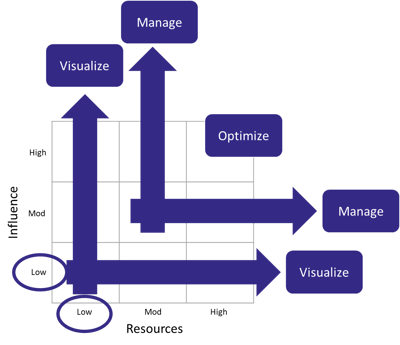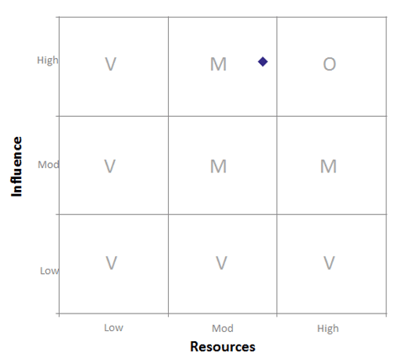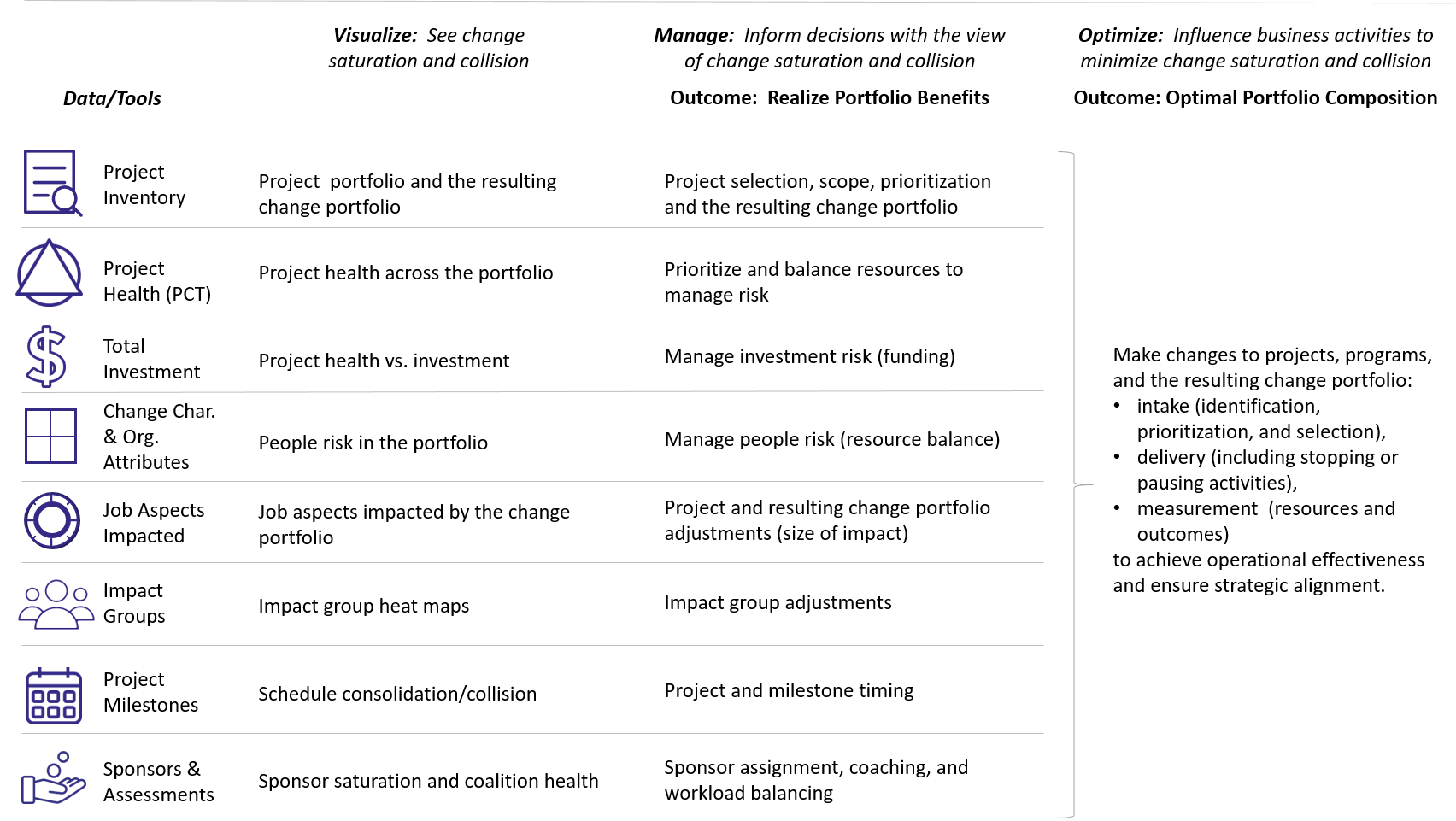Introduction to Change Portfolio Management

6 Mins
Updated: October 17, 2025
Published: August 23, 2018

Change management is the discipline that guides how we prepare, equip and support individuals to successfully adopt change in order to drive organizational results and outcomes. Change management provides a structured approach to support the transition from the current state to the future state in the context of each unique change.
What happens, however, when numerous projects or initiatives introduce multiple, often simultaneous changes? The increased volume, velocity, and complexity of changes that we see across industries and organizations is resulting in:
- Change saturation – individuals and organizations experience more change than can be absorbed
- Change collision – too much change is happening at once, resulting in conflicts in timeframe, resources and mindshare
At the individual level, the consequences of change saturation and collision are disengagement, anxiety, confusion, stress and fatigue. At the group level, the consequences are lack of necessary resources, poor project delivery, and little direction from senior leaders. And, at the organization level, the consequences are lack of focus, turnover, and low morale. In the most recent Prosci Best Practices in Change Management study, 78% of respondents said their organizations were nearing, at, or past the point of change saturation. In other words, "change turbulence" and the negative consequences have become the norm.
Change Portfolio Management
Change Portfolio Management is a structured approach and set of tools for managing the cumulative and collective impact of a portfolio of change. Change Portfolio Management introduces a new perspective—like getting above the forest canopy so you can see the forest for the trees. This perspective is necessary to see the situation more holistically, introducing a new opportunity and a new set of challenges.
The Scope, Influence and Resource Challenge
The first inclination when considering the scope of the change portfolio is to draw your boundary around the whole forest – every project or change initiative that is happening organization-wide. In some cases, that may be the right answer. In many cases, however, the broader your scope, the more difficult it is to see what is happening, influence key decisions, and have the available resources to contribute to the desired outcomes.
Prosci recommends giving consideration to each of these factors before taking action to manage the change portfolio:
Scope
Decide on the magnitude of the scope of the change portfolio; is it workgroup, department, function, cross functional, or enterprise? What does the portfolio contain? Does it contain similar changes or types of impact such as the strategic projects or IT change initiatives? Or does the portfolio contain a view from the impacted group or project team (i.e. all changes impacting a specific group or all changes being led by a project or program team)?
Once you decide on the scope, now you should give consideration to the level of influence and available resources for the change portfolio.
Influence
Start by considering how much you can influence the outcome of the change portfolio. Can you influence:
- The entry or exit of projects in the portfolio?
- The investment in them?
- Resource assignment and adjustment?
- Impact group adjustments – by timing, degree of impact or sequencing?
Other areas of influence include milestone timing, stopping or pausing a project, sponsor assignment and strategic alignment.
Resources
Next, give consideration to the amount and types of resources available. Are you a team of one or 10 or 50? What other organizational resources do you have available to you in your project management office (PMO) or change portfolio resources? What level of sponsorship do you have and how engaged are they in addressing the change portfolio challenges you are identifying?
The Path Forward: Visualize, Manage, Optimize
Once you select the change portfolio scope, consideration is given to the key factors of influence and resources. These factors have been incorporated into the Prosci Portfolio Scaling Plot (an Excel-based tool), which can be used to define where you uniquely find yourself in regard to the types and number of changes in your organization, your level of influence, and your available resources to guide your recommended change portfolio management approach: Visualize, Manage, Optimize.
- Visualize – The primary focus is on seeing change saturation and collision; we can see the forest
- Manage – The primary focus is to inform key decisions with the view of change saturation and collision; we take action in context of the forest
- Optimize – The primary focus is on actively influencing business activities to minimize change saturation and collision; we can change the forest
Each of these outcomes are depicted in the three-by-three scaling plot below, representing different change portfolio management approaches.

Scenario 1: Low Change Portfolio Resources – Across all levels of influence (low, moderate or high), the optimal path is Visualize
Scenario 2: Low Change Portfolio Influence - Across all levels of resources (low, moderate or high), the optimal path is Visualize
Scenario 3: With moderate or high resources aligned with moderate or high influence, the optimal path is Manage
Scenario 4: With high resources and high influence, the optimal path is Optimize
The output of the Prosci Portfolio Scaling Plot is a visual that defines the recommended approach for change portfolio management at your organization. A sample output of this plot is shown below:

The Visualize Path
Having the ability to see change saturation and change collision is the starting point for Change Portfolio Management. In many cases, the first visual we think of is a heat map. A heat map is a visual representation of the change portfolio through the lens of a target group (or groups). It is one of the primary visualization tools that show what changes are happening, who they will impact, the degree of impact, and when they will be impacted through color-coded display (cooler and hotter). A heat map is very helpful, but there are lots of elements of the change portfolio we can visualize.
To begin, ask yourself the question, “What decisions do I need to inform with the visualizations?” You may discover that you need to make resource decisions based on project health, decide how to address sponsor saturation concerns, make impact group adjustments, or change project and milestone sequencing and timing. There is a different set of data required to inform those decisions than what is required to build a heat map.
If you land in the Visualize area of the plot, you most likely do not have the influence or resources to force the organization to do something based on your visualizations. Your best approach is to influence decisions and behaviors and build the business case for structured change portfolio management by creating useful and impactful change saturation and change collision visuals.
The Manage Path
We don’t want to just see change saturation and collision; we need to take action to manage saturation and collision. With the appropriate level of influence and resources, we can work in partnership with project, program and portfolio managers and the associated senior-level sponsors to ensure alignment, realize economies of scale in project delivery, and improve benefit realization.
On the Manage path, we spend time building decision models to guide and direct the data we need to collect and the visualizations we need to provide. We focus on establishing common data about each change—types of change, normalized impact groups, and degree of impact. It is time-consuming and expensive to collect, analyze, report and sustain the data and information needed to inform decisions. By taking this approach, we consider the decisions we need to inform first and then collect the required data.
The Optimize Path
On this path, we are considering what needs to change in order to minimize change saturation and change collision. The purpose of the Optimize path is to make changes to business activities like:
- The project intake process; project identification, assessment, selection, and timing from the change portfolio perspective
- Sponsor engagement and leadership support aligned with and in support of our efforts
- Integration with the strategy formation process to participate at the source, where projects and initiatives are considered before they enter the project portfolio and the resulting change portfolio
All of these are completed with the intent of achieving operational effectiveness and ensuring strategic alignment of the in-scope projects and change initiatives and the resulting portfolio of change.
Extending the Prosci Methodology and Tools to the Change Portfolio
For organizations that are familiar with and utilizing the Prosci 3-Phase Process, the tools and diagnostics that are utilized in the context of an individual project or change initiative have natural extensions to the change portfolio. Each of these has an aspect of Visualize, Manage, and Optimize depending on how they are leveraged to deliver successful projects, realize portfolio benefits, and optimize portfolio composition:

Change Portfolio Management Dashboard
All of this data can be collected and summarized in a way that sheds light on the impacts of each individual project or change initiative and the change portfolio as a whole. Prosci is developing new tools in this area, including a Change Portfolio Management Dashboard (currently a prototype for future development) to provide this view of the change portfolio. The objective is to ensure the data collected and output produced can be aligned with existing project portfolio management (PPM) or change portfolio management activities already underway in your organization.
Change Portfolio Management X Factor
Change Portfolio Management at its core is about managing the cumulative and collective impact of change to achieve the desired outcome, ROI or benefit realization. Our view above the forest canopy—at the portfolio level —offers significant benefits to our change management efforts, but it requires influence and resources to get there.
There is an interesting effect that occurs when you follow the approach outlined in this article; let’s call it the “Change Portfolio Management X Factor.” Consider for a moment what happens when your organization’s overall change management capabilities and competencies increase (on an individual project or change initiative) - change capacity increases, and change disruption decreases. Similarly, when you focus your change portfolio management efforts, as guided by the Prosci Portfolio Scaling Plot, it is likely you will begin to increase your influence and resources because of the value you bring to the table.
Take the Change Portfolio Management Challenge
What actions are you going to take as a result of reading this article? Take the challenge of stepping into Change Portfolio Management armed with a new perspective. Let us know what insights you gained as a result and we will share them with other change practitioners embarking on the Change Portfolio Management challenge. Together, we will create an approach that is actionable and attainable led by Prosci research and world-class Prosci Methodology.




